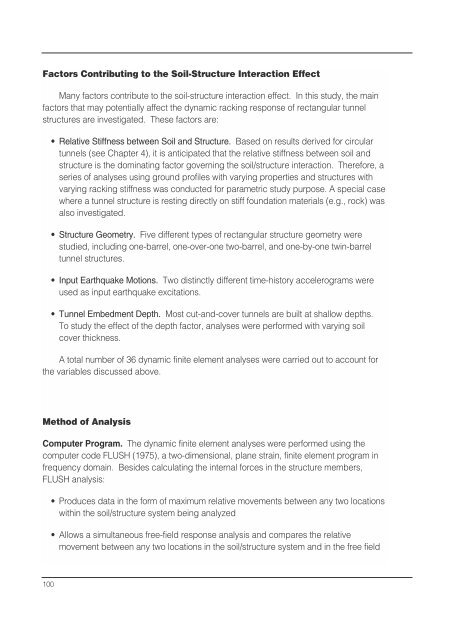Seismic Design of Tunnels - Parsons Brinckerhoff
Seismic Design of Tunnels - Parsons Brinckerhoff
Seismic Design of Tunnels - Parsons Brinckerhoff
You also want an ePaper? Increase the reach of your titles
YUMPU automatically turns print PDFs into web optimized ePapers that Google loves.
Factors Contributing to the Soil-Structure Interaction Effect<br />
Many factors contribute to the soil-structure interaction effect. In this study, the main<br />
factors that may potentially affect the dynamic racking response <strong>of</strong> rectangular tunnel<br />
structures are investigated. These factors are:<br />
• Relative Stiffness between Soil and Structure. Based on results derived for circular<br />
tunnels (see Chapter 4), it is anticipated that the relative stiffness between soil and<br />
structure is the dominating factor governing the soil/structure interaction. Therefore, a<br />
series <strong>of</strong> analyses using ground pr<strong>of</strong>iles with varying properties and structures with<br />
varying racking stiffness was conducted for parametric study purpose. A special case<br />
where a tunnel structure is resting directly on stiff foundation materials (e.g., rock) was<br />
also investigated.<br />
• Structure Geometry. Five different types <strong>of</strong> rectangular structure geometry were<br />
studied, including one-barrel, one-over-one two-barrel, and one-by-one twin-barrel<br />
tunnel structures.<br />
• Input Earthquake Motions. Two distinctly different time-history accelerograms were<br />
used as input earthquake excitations.<br />
• Tunnel Embedment Depth. Most cut-and-cover tunnels are built at shallow depths.<br />
To study the effect <strong>of</strong> the depth factor, analyses were performed with varying soil<br />
cover thickness.<br />
A total number <strong>of</strong> 36 dynamic finite element analyses were carried out to account for<br />
the variables discussed above.<br />
Method <strong>of</strong> Analysis<br />
Computer Program. The dynamic finite element analyses were performed using the<br />
computer code FLUSH (1975), a two-dimensional, plane strain, finite element program in<br />
frequency domain. Besides calculating the internal forces in the structure members,<br />
FLUSH analysis:<br />
• Produces data in the form <strong>of</strong> maximum relative movements between any two locations<br />
within the soil/structure system being analyzed<br />
• Allows a simultaneous free-field response analysis and compares the relative<br />
movement between any two locations in the soil/structure system and in the free field<br />
100
















